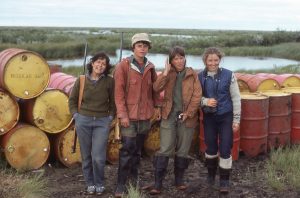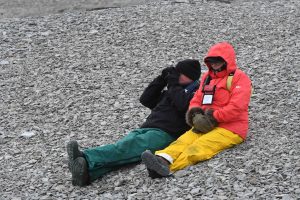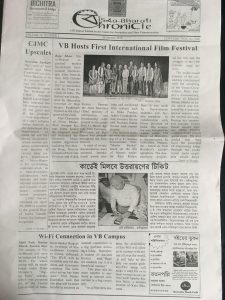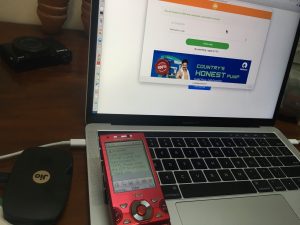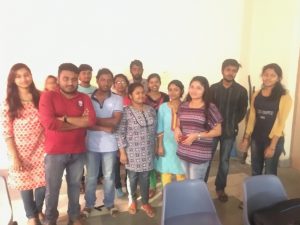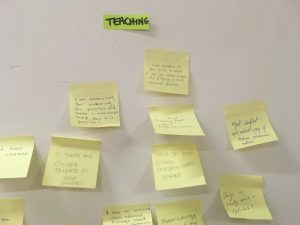I began my career as a field ecologist on the remote shores of Hudson Bay, where I spent between two and four months off the electrical grid for five successive summers (1980-84). That's me at far left, with a rifle for polar bear protection.
A generator charged the car battery that powered the radio that we used for our daily check in with the Churchill Northern Studies Centre. One summer, we briefly had the use of a satellite phone. It came in a small suitcase and was very expensive to use. It was quite thrilling to realize how it extended our communications reach beyond Churchill, all the way to Toronto!
How times have changed. These days, satellite phones are not much larger than my cell phone from the late 1990s. Broadband internet access is 60-125% in much of the Global North, though for many in Canada’s north, which is our Global South, the cost of slow internet and cell phone access is exorbitant.
I have grown used to high speed internet. These days, when I am in the arctic for a few weeks, I find slow or low internet access frustrating. I simply go offline 100%, and sleep on high arctic beaches instead of watching YouTube.
In the arctic, I experience the other side of the digital divide: the “gap in terms of access to and usage of information and communication technology”. While Canada has reached high internet access, it's still a huge issue for many low-income families, especially given that the internet is a key educational resource and essential knowledge for capacity-building.
Santiniketan, West Bengal
I am currently experiencing the digital divide for a much longer period. Since early January, I’ve been living in rural Santiniketan, West Bengal. This is the home of Visva Bharati, the university founded by legendary poet and scholar, Rabindranath Tagore.
While internet access exists in theory, in practice, it is highly variable and unpredictable. I now know exactly why Twitter, a micro-blogging platform, is so useful in low bandwith situations. Tweets are often the only digital content that loads for me.
Three days after I arrived, I figured out that the university wifi access was too limiting for my work. Loading one webpage took about 3 minutes and most of my data allowance. A week later, the local student newspaper ran a story about plans to boost the internet infrastructure of the university. So, I had arrived at a good time! Or had I?
In addition to my Jio wifi hotspot dongle, as it is called, which gives me 2 Gb of daily data, I have the increased wifi access via the university of 1Gb daily for a total of 3Gb. This is THEORETICAL, because it is evident that the overall bandwidth availability in this region can’t support the sum of the local demand. Most days if I can get connected, for longer than 5 minutes before my wifi drops, pages still take ages to load. I have never managed to max out the 3 Gb and I am not alone.
High Speed Internet Infrastructure tends to be in urban locations
I don't know much about India's high speed fibre optic internet structure, but I'm pretty sure there's not much of it near me. I'm also fairly certain that my unpredictable internet access is a consequence of WHERE I am living, 150 km from Kolkata. Eduroam exists at more than 75 institutes of higher education in India, but it's not here, and if it was, I suspect that in the absence of optic fibre, it would be hampered by local bandwidth limitations.
A 2017 article in The Hindu confirms this. The distribution of high speed internet access is highly patchy, with the popularly quoted figure of 28% overall internet access apparently painting an unrealistic picture. Rural areas have only about 13% access.
Most academic work these days relies on a fast, reliable internet connection. Unreliable internet means me having to pick and choose which emails to read or reply to, and I simply cannot load many content heavy pages. I wrote this post in a word document and uploaded small size photos to save on data.
While I'm here, I'm helping environmental studies students to improve their science communication skills and learn about doing public science, citizen science and outreach and engagement, but everything is hampered by internet access and bandwidth limitations.
While India's internet access is increasing, people are currently using their smart phones to primarily consume entertainment. Talking with students, I have learned that the internet is not generally perceived as an educational resource with which users can interact, rather than simply consume content. Harnessing the power of the internet for improved human and environmental security, via increased access to knowledge for the public good, means that different kinds of usage must be encouraged.
I feel like I've been on a bit of a rant about my internet access, but it's actually been very good for me to see how the other half of the digital divide lives. While I'm all about using appropriate technology, like sticky notes and pencils, and avoiding use of the internet where possible in the current situation, like at our science communication Unconference, at the end of the day, predictable internet is vital for empowering local people, and for building capacity amongst the excellent students who will be key to making this happen.

